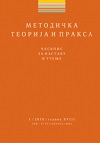ИЗОМЕТРИЈСКЕ ТРАНСФОРМАЦИЈЕ У РАЗВОЈУ ПРОСТОРНОГ РЕЗОНОВАЊА
ISOMETRIC TRANSFORMATIONS IN THE DEVELOPMENT OF SPATIAL REASONING
Author(s): Rada ŠćepanovićSubject(s): Social Sciences, Education, Preschool education, School education, Sociology of Education, Pedagogy
Published by: Zajednica učiteljskih fakulteta Srbije
Keywords: isometrics;spatial reasoning;two and three-dimensional objects
Summary/Abstract: Translating, rotation and symmetry, i.e. isometric mapping, and their compositions are transformations that do not distort the shape and size. The aim of this paper is to demonstrate that various examples of isometric transformations encourage the early development of students' spatial reasoning. The basic starting points of this work are: (1) the connection between school geometry and spatial reasoning, and (2) the characteristics of spatial reasoning in children and instructions in encouraging the development of their spatial abilities. The results that have been obtained by the method of theoretical analysis show more approaches that encourage the development of spatial reasoning skills in children, from conversations with teachers and peers, game matching, drawing, and reconstruction of three-dimensional objects to the use of software packages and touch technologies. In isometric tasks, students first use visualization, to evaluate which forms are matched, compare forms, mentally and physically rotate the shapes received and recognize shapes from different perspectives. It has been concluded that there is clear evidence that even the youngest students, if offered high quality opportunities, can be engaged in challenging activities of isometric transformations. Therefore, transformations can be introduced to primary school students, not directly with explicit definition, but in an informal way, choosing an appropriate context so that geometric activities for students have meanings. In order for students to gain understanding and insight into these fundamentally difficult aspects of isometric transformations, they must be rooted in the experiences that students have on a daily basis, as well as in the tasks set by the teacher. Conclusions point out to the importance of designing isometric tasks and teacher mediation, especially with regard to the use of such software, as a catalyst for the development of culture, in a classroom, where teachers and students expand their beliefs about learning and understanding isometrics.
Journal: Методичка теорија и пракса
- Issue Year: 19/2019
- Issue No: 1
- Page Range: 133-154
- Page Count: 22
- Language: Serbian

